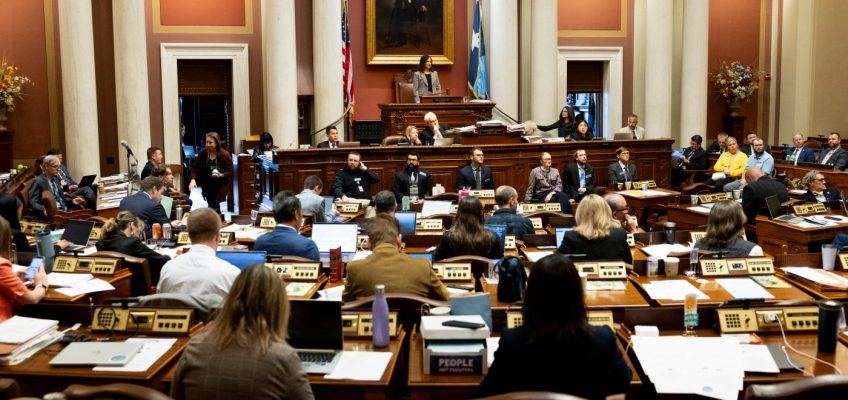Seven candidates are vying for the state House seat left vacant by former St. Paul Rep. Kaohly Her, who resigned from the Minnesota Legislature last month after winning the St. Paul mayoral race.
Six of those candidates are seeking the DFL Party nomination and are headed to a special primary election on Tuesday, Dec. 16. Early voting started this week.
Top issues in the race include addressing rising St. Paul property taxes and the growing cost of health care and housing.
Candidates say the Legislature should do more to help the city handle costs as declining commercial property values place a greater burden on residential property owners.
St. Paul has many colleges, government buildings and places of worship that don’t pay property taxes. That poses a further challenge.
DFL candidates also say they hope to push back against the administration of President Donald Trump, who they say is “terrorizing” immigrant communities of the state.
House District 64A
The winner of the Jan. 27 special election will represent House District 64A, which includes the Union Park, Macalester-Groveland and Summit-University neighborhoods. The district heavily favors Democrats and has attracted a competitive primary contest.
Candidates had to pull their campaigns together fairly quickly: Her resigned Nov. 17, and the deadline to file paperwork to run was Nov. 25.
Registered candidates seeking the DFL endorsement include: former Deputy Secretary of State Beth Fraser; Ramsey County civil servant Matt Hill; labor lawyer Meg Luger-Nikolai; progressive organizer Dan McGrath; health care executive Lois Quam and assistant attorney general John Zwier.
Business owner Dan Walsh is the only Republican. His message is largely focused on combating fraud in state government programs.
Beth Fraser
Beth Fraser. (Courtesy of the candidate)
Beth Fraser is a former deputy secretary of state under Secretary of State Mark Ritchie and a current legislative staffer. She helped create and oversee the Safe At Home Program, an initiative at the Secretary of State’s Office that allows victims of domestic violence to hide their addresses.
Fraser said she would help Minnesota resist federal immigration enforcement under the Trump administration by backing measures barring state and local law enforcement from cooperating with ICE. She hopes to address the growing cost of living by pushing for state programs that help with health care, child care and housing.
During a League of Women Voters candidate forum on Tuesday in St. Paul, Fraser said the state needs to fund programs by creating a fifth-tier income tax for the highest earners and “closing corporate income tax loopholes.”
Fraser has the endorsement of the former secretary of state she served under. Others include St. Paul City Council Vice President Hwa Jeong Kim, St. Paul Ward 1 Councilmember Anika Bowie, state Sen. John Hoffman, DFL-Champlin, and state Sen. Scott Dibble, DFL-Minneapolis.
Matt Hill
Matt Hill. (Courtesy of the candidate)
Matt Hill has worked as an aide for Ramsey County commissioners in various capacities, including on pandemic policy and the justice system. He says his top priorities are improving community safety, affordability, and trust in government.
A central feature of Hill’s campaign message is his call to do more to fight fraud in state programs.
“I think people are just sick and tired of just another story and another headline of mismanagement,” he said.
On the community safety side, Hill says he would support “fully funded, well-trained public safety professionals” and “community-centered safety strategies, including mental health response teams, youth outreach, and violence prevention programs.”
Meg Luger-Nikolai
Meg Luger-Nikolai. (Courtesy of the candidate)
Like many candidates seeking the DFL nomination, labor lawyer Meg Luger-Nikolai says rising property taxes are at the top of the mind for voters.
She supports boosting local government aid from the state and adjusting the state’s education funding formula to provide more money to St. Paul Public Schools.
“I think the possibility of having some equalization aid to make up for that lack of tax base would be really helpful,” she said. “That would take some burden off of taxpayers overall.”
Luger-Nikolai supports creating a statewide health insurance system that guarantees affordable and accessible care, increasing taxes on corporations and the wealthiest Minnesotans.
She says state leaders need to do a better job explaining to voters how they’ve fought government fraud in recent years, such as creating a dedicated office of inspector general at the Minnesota Department of Education.
Luger-Nikolai has the DFL endorsement. She is also backed by several labor groups, including the St. Paul Federation of Educators, and the Minnesota Association of Professional Employees, which represents government workers.
Senate Majority Leader Erin Murphy, former representative Her, and State Auditor Julie Blaha are among the DFL elected leaders who have endorsed Luger-Nikolai.
Dan McGrath
Dan McGrath. (Courtesy of the candidate)
Progressive organizer Dan McGrath says his background as a “coalition builder” will help him achieve the goals he and other DFL candidates share, like addressing the affordability of health care and housing.
McGrath is the former director of TakeAction Minnesota, where he advocated for expanding MinnesotaCare, raising the minimum wage, legalizing same-sex marriage and stopping a 2012 voter identification ballot measure.
“In this political climate, what we need are people who can bring people together in order to get big things done,” he said, pointing to his experience working in farming and rural communities and with labor groups.
McGrath supports the Minnesota Health Plan — a single statewide health insurance program. It would push private insurers out of MinnesotaCare — a move he says could save money and make the health care system “more publicly accountable.”
Like the other DFL candidates, McGrath wants more local government aid for St. Paul.
Lois Quam
Lois Quam. (Courtesy of the candidate)
Lois Quam is a health care executive with long ties to DFL politics who chaired the commission that led to the creation of MinnesotaCare, the state’s public health insurance program. She also is involved in negotiations between the University of Minnesota, Fairview Health Services and M Physicians over funding the state’s medical school.
She later advised Hillary Clinton on national health care reform and served in the Obama Administration State Department as a lead on global health initiatives.
Quam says her business and nonprofit leadership — as well as her experience at local, state and national levels of government — equip her to be an effective legislator.
A top concern in District 64A, she said, is that the city of St. Paul gets the “attention it needs” from the Legislature, Quam said. Quam also says attracting businesses back to downtown St. Paul will be key to growing the tax base.
Like other DFL candidates, she says raising taxes on higher earners and corporations is the best way to fund services.
Quam has endorsements from Minnesota Attorney General Keith Ellison, St. Paul Ward 3 Councilmember Saura Jost and St. Paul Ward 4 Councilmember Molly Coleman.
Dan Walsh
Dan Walsh. (Courtesy of the candidate)
Dan Walsh, a St. Paul small business owner, is the sole Republican candidate. It’s not the first time he’s run in House District 64A. Walsh ran against Her in 2022 and 2024. In both years, Her had more than 80% of the vote.
Fighting government fraud is a top issue for Walsh, who said he thought DFLers were downplaying the problem, which has cost the state hundreds of millions of dollars in recent years.
“How could you even talk about anything else?” Walsh said. “Where should the buck fall? Someone’s got to be held accountable.”
In a candidate questionnaire with the St. Paul Area Chamber, he said his top three priorities were “public safety, public safety, and public safety.”
“We can get into many different topics, such as education, economic development, but if we do not have the ability to operate and live in a safe community all these other issues are irrelevant,” he said.
On his campaign website, Walsh said he wants Republicans to break the partisan tie and gain a majority in the House so they can more aggressively investigate government fraud. Walsh says he also hopes to lower taxes and improve outcomes in education.
John Zwier
John Zwier. (Courtesy of the candidate)
John Zwier, an assistant attorney general for the State of Minnesota, said he decided to run after this summer’s assassination of former House Speaker Melissa Hortman and her husband, and the shooting at Annunciation Catholic School in Minneapolis, which took the lives of two young children and injured 30.
“There was a lot of frustration with government,” he said. “Even with a summer like we just had, and with the tragedy at Annunciation, that still we couldn’t get a special legislative session together to make some common sense gun laws that would help reduce gun violence.”
Before joining the Attorney General’s Office, Zwier worked at the forfeiture section of the U.S. Attorney’s Office, where his work involved returning money and assets to victims of crime. He also served as a judge advocate in the U.S. Army Reserve.
Zwier shares many viewpoints with the other DFL candidates on local government aid and affordability. His overall message focuses on advancing gun control legislation. In November, he wrote an opinion piece in the StarTribune advocating for a law requiring firearms in public to have visible trigger locks.
Related Articles
Minnesota projects $2.5B surplus for now, $3B shortfall later in decade
State funding secured for plans to honor Gordon Parks in St. Paul
How will Kaohly Her’s legislative career shape her leadership of St. Paul?
Report revives claims Minnesota fraud funded terrorists. Here’s what we know.
Washington state’s paid leave program struggles. Will MN be different?




